 It takes a whole community to put on the firey celebration of Beltane (la Bealtaine in Irish), replete with music, dance and ceremony. Many of us who are of European ancestry did not grow up within the intact indigenous traditions of our ancient ancestors. But, being human, we naturally long for ways to honor the Earth, root ourselves in a sense of place, and experience the changing gifts of the seasons. So we try to bring new life to some of the old ways, recreating them to meet the current needs of our community.
It takes a whole community to put on the firey celebration of Beltane (la Bealtaine in Irish), replete with music, dance and ceremony. Many of us who are of European ancestry did not grow up within the intact indigenous traditions of our ancient ancestors. But, being human, we naturally long for ways to honor the Earth, root ourselves in a sense of place, and experience the changing gifts of the seasons. So we try to bring new life to some of the old ways, recreating them to meet the current needs of our community.
In Irish cosmology the cycle of the seasons, pictured as a circle, is quartered by the sun’s solstices and equinoxes. This wheel of the year is also cross-quartered to mark the points in the progression of the agricultural year: Imbolc for preparing, Bealtaine for planting, Lughnasadh for harvesting, Samhain for resting.

We are at Beltane, halfway between spring equinox and summer solstice. While Samhain ushers in the dark and lean half of the year, Beltane marks the beginning of the abundance and creativity of the bright half of the year. With Beltane comes the beginning of summer, bringing with it all the renewed hope and joy in the re-emerging fertility and fruitfulness of the people, the animals, and the land through the sacred marriage of sun and earth.
Like Samhain, Beltane is an especially thin time when the Otherworld might reveal itself, and the spirits of the land are apt to emerge to add their magical powers to the festivities. Like many of the cross-quarters, Beltane is a fire festival. Bealtaine means “bright fire.” In ancient Ireland bonfires were lit on the tops of hills at special sacred sites of assembly. All household fires were extinguished and embers or torches were taken from the central fire to rekindle those of the hearth. Music and dance and games were part of these ceremonies. They were about reconnecting the people of the community to each other and to the life-giving sun. In The Book of Invasions, written in Old Irish, we learn that the first Bealtaine fire lit in Ireland was kindled by the druid Mide at Uisneach. This is the “Stone of Divisions” on the Hill of Uisneach, which marks the middle of Ireland where the provinces come together:
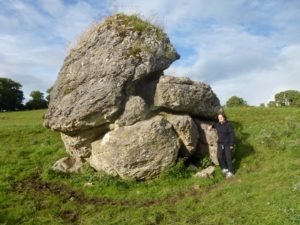
The Hill of Uisneach, at the mythical center of Ireland, was the site of the largest of these Bealtaine festivals, or so the legends about the druids always said. Recent archeology has found the remains of huge bonfires, confirming the truth of the old stories. Magnificent Beltane gatherings are taking place there once again.
Lest we think that these gatherings originated with those 600 BC Gaelic Celts, descending still deeper in time to 1,500 BC, we find a stone circle of sixty-four boulders called Beltany. Situated on the heights of Tops Hill (anglicized from a Gaelic word meaning ‘the lighting of a ceremonial torch’), it is one of the largest stone circles in Ireland. There is a highly decorated stone within the circle, a triangular stone. At the point of this triangle the sun rises on Beltane.
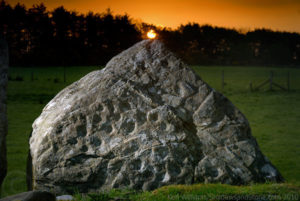
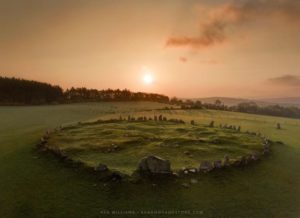
At Beltane, on green sanctified farmland called One Spirit, we gather “on the hill,” as it’s always been called, to recreate the archetypal circle with music and dance and ceremony. In Piedmont North Carolina May Day, as it’s called in English and Germanic speaking countries, is usually a day of warm sun, cool breezes, impossibly blue skies and big puffy white clouds, except when it rains softly on the fields. Here and there girls pick wildflowers in the grasses to weave into garlands for their hair while butterflies flit about.
As celebrants arrive, walking up the hill past the wagon wheel decorated with flowers, we are greeted and smudged with sage to purify and mark the transition as we enter onto sacred ground. We are each given a long colorful ribbon onto which to write a prayer. These are received, rewound, and placed together in a waiting basket.
Beltane is not just a fire festival, it also honors water. In Ireland many people pilgrimage to holy wells at this time to seek healing from the consecrated waters. We, too, begin with a pilgrimage to a sacred spring. With drums and rattles and handfuls of birdseed we bless and make offerings to the trees and to the nature spirits as we make our way on a winding path through the woods.
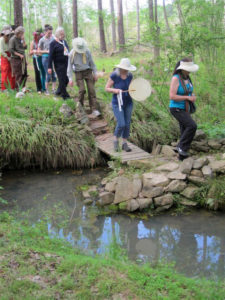
Arriving at an arbor decorated with colorful ribbons and flowers, we pause before crossing the threshold mindfully into the sacred space. Prayer clooties (strips of cloth) are often tied to guardian “fairy trees” at holy wells. Crossing over a tiny bridge we are given clooties to dip into the healing waters. We each find a quiet place to hang our prayers for healing on bushes and trees. In rural England villagers “dress” wells with flowers and seeds and shells. We have placed pots of flowers around our wellspring. Rounding the spring sunwise, we scatter our offerings of rose petals in gratitude to the water for purification and healing, as we sing: There’s water in the well, there’s water in the well, there’s water in the well, all is love . . . Seen and unseen, known or forgotten, ever rising in the well, all is love. . .¹

To the beat of a shaman drum we sit in silence at this portal to the Otherworld, journeying for vision and inspiration to the well of wisdom. One woman envisions us dancing. Another starts drumming. We dance to quicken the flow of our own liquid energies, our fluid wildness joining the wild around us. Now, in this season of Covid-19, as we look into the waters, what visions arise for healing our post-pandemic world? Can we envision a way in which the natural wildness of our bodies can thrive along with the wild life of the rest of the natural world?
When the dancing subsides we pray for the honoring and protection of all of our fresh waters and for the waters of this watershed, for this creek as it flows into the Rocky River, the Rocky into the Deep, the Deep into the Haw, the Haw into the Cape Fear, the Cape Fear into the Ocean singing:
The river is flowing, flowing and growing. The river is flowing, down to the sea . . . Oh Mother carry me, your child I will always be. Oh Mother carry me, down to the sea. . . .
The first waters taken from a well or spring at Beltane are deemed especially sacred. One of our pilgrims dips water into a ceremonial horn to carry in procession back through the forest as we sing: We will never, never lose our way to the well of Her memory . . . And the power of Her living flame it will rise, it will rise again. Like the grasses through the dark, through the soil, to the sunlight, we will rise again. We are thirsting for the waters of life, we are moving. We shall live again.² Later we will pour this water as a libation on the altar at the base of the old Grandmother Apple Tree to honor the Divine Feminine and on the Earth at the base of the Maypole to honor the guardian ancestors.
Arriving back at the bright, sunlit field, we find the last of our ribbons being tied to the brilliant sun-topped Maypole, which has been encircled with an exuberant ring of sunflowers golden day lilies and daisies, “day’s eyes.” In spring many cultures honor the Sacred Tree with garlands and beautiful ribbons, songs, and circle dancing.
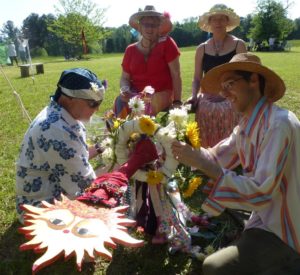
As the community claps raucously to add our strength to the effort, the tall cedar pole is raised, honoring those who identify as Divine Masculine, and set into a pit lined with ancestor-honoring rocks. Thus the Tree of Life connects Earth below with Sky above.
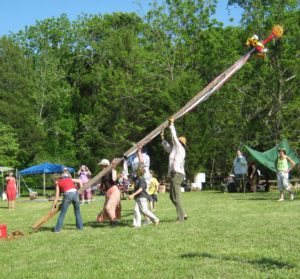
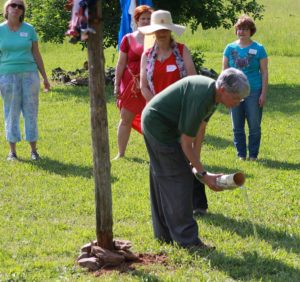
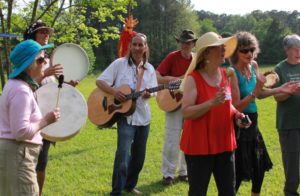
The musicians assemble around the symbolic World Tree. Everyone forms a huge circular rim around this central axis of the wheel. The ceremony begins with giving gratitude to the spirits of the land and to the wise and loving ancestors who cared for this sacred ground before us. We extend appreciation to the many people who have hallowed this sacred ground over the years with so many ceremonies, making it a temenos. Temenos means sanctuary, a field of divinity. In the large circle with guitars and drums we dance, calling to the benevolent Spirits of the Directions to bring us their blessings: We call to the power of the Thunder Beings, we call to the power of the Earth. We call to the power of the East and West. We call to the power of the North and South. Behold the time has come, the time has come to unite as one. Behold the time has come, to encircle the Earth with our love. Then, facing the colorful elemental personages at each direction, we sing our favorite: Behold there is magic all around us . . . awaken, rejoice and sing.
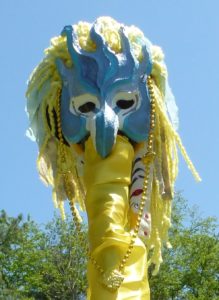
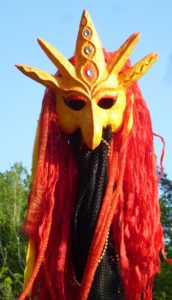
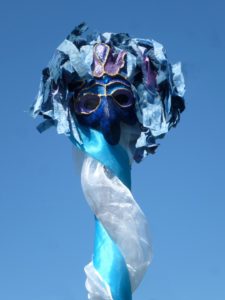
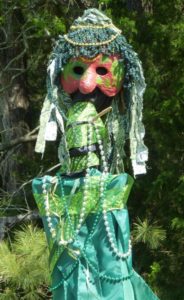
Our breaths catch as the colorful ribbons are stretched out like a huge tent, like a mandala, from the top of the tall cedar pole. The musicians play Irish tunes and the singers chant Earth-honoring chants vigorously to help spur on the dancers: Earth my body, Water my blood, Air my breath, And Fire my spirit . . . as those moving sunwise meet and weave over, then under, those coming moonwise towards them. Faster and faster, the dancers skip and the chanters chant. Round and round we go, we hold each other’s hands. And weave our lives in a circle. Our love is strong, the dance goes on . . . The dancers are weaving colorful chevrons of intertwined energies descending the pole, fervently helping to bring the light of the sun down to fertilize the Earth. Fortunately, the last dancers at the end of their ribbons are often children or lithe young souls!
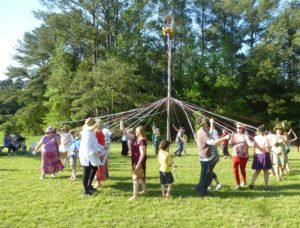
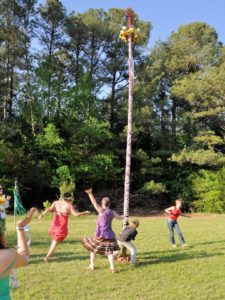
Admiring the beauty of our creation, we then read the pattern as an oracle to glean the solemn, and often humorous, meaning of what we have woven together, one person after another calling out what they see in the woven pattern. The whole community’s prayers and intentions will stay up there on the winds until Samhain, when they will be taken down, still woven, looking for all the world like a shed snakeskin, and released to the Samhain fire.
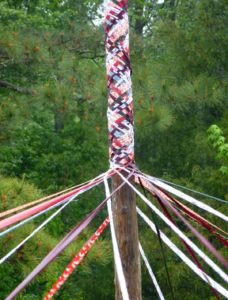
Now it is time to crown the Green Man King and May Queen. This is a re-enactment of the Sacred Marriage of the King who, to be a true King, must marry the Goddess of Sovereignty, who is the land, for the fertility of the Earth and consequent prosperity of the tribe. (Imagine what it would be like if our world leaders had to make a marital vow to honor their lands!) Then the feasting begins.
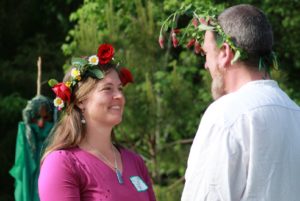
By the time the potluck feast has ended, the sun has descended behind Grandmother Apple Tree. It is dusk, and the wonderful mythos of the Fire Ceremony begins. In the earliest Irish texts we are told that the druids made two fires, with great incantations, and drove the cattle between them to protect them and keep them healthy, as they are moved from their winter enclosures to summer pastures on the hills above. The people dance and jump through these flames for health and fertility, too!
The King and Queen are given the honor of lighting the twin ritual fires. They place upon them bundles of twigs of nine sacred woods, as in the Scottish tradition. We take this opportunity to bless the woods of our region: cedar, oak, ash, hawthorn, holly, pine, chokeberry (our rowan), hickory, and dogwood. We add our breath to encourage the fires to kindle. As the first flames begin to glow deep inside, someone begins to sing: Fire, fire, fire, kindle my spirit, fire. In your flame, naught remains, but fire, fire, fire.³ We all join in singing as the fires catch and the flames begin to leap high.
While the musicians play, the group forms two lines, friends joining hands to make a human arbor on one side of the fire. Each person passes through the arbor and through the fires, invoking surrender and purification. The arching tunnel re-forms on the other side. Our procession winds back through the tunnel and through the fires again. This time we ask the spirit of fire to renew us, to ignite our passions, to illuminate our hearts.
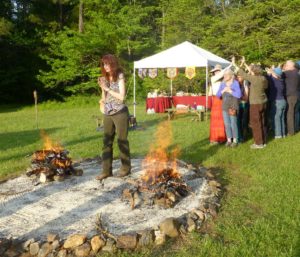

Emerging from the flames, we peel off to form a circle around the twin fires. As each person lights a stick of cedar in the fire and gives voice to their deepest hopes and intentions, we quietly sing the Beltane Brand over and over again: The wheel of the year is turning, and the Beltane fires are burning, so give your hand, and take your brand, to kindle your own hearth’s yearning, to kindle your own heart’s yearning. Still singing, we stand in the darkness holding our glowing firebrands and are witnessed as we proclaim our passionate hopes for our community and for the world. We will take these brands home to light our own fires and to remind us of our commitment to bringing our heart’s desires to fruition.
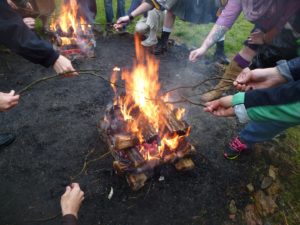
At this Beltane season, when we cannot meet in person, and such great change is needed, let’s ask what passionate hopes for our world burn brightly in our hearts?
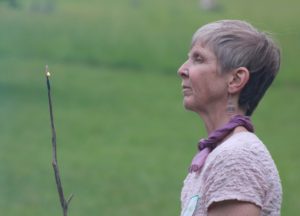
Then we break into groups of four and five to form small wheels, and dance the Beltane Brand Dance4, re-forming our wheels each time through. Finally we join into one large wheel and dance again: The wheel of the year is turning, and the Beltane fires are burning, so give your hand, and take your brand, to kindle your own hearth’s yearning, to kindle your own heart’s yearning.
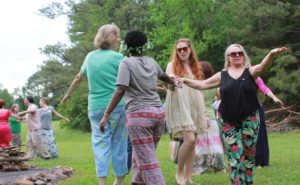
What delights me most about these gatherings is being surrounded by such a lively mix of ages from 6 to 75, little kids, teens, young adults, on up to us elders, all sharing the ceremonies and dances together. There is time for one more dance at the fire for blessing our relationship to all our fellow beings: May I walk in beauty, may I walk in peace . . . All my relations, all my relations . . . All life is sacred, the mountains and the seas. All life is sacred, the animals and the trees . . . All my relations, all my relations . . .5

We ritually close the circle and dance our favorite parting dance: May the circle be open, yet unbroken, may the love . . . joy . . . peace of the Goddess be ever in our hearts! Merry meet and merry part and merry meet again.
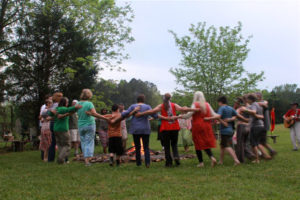
After the ceremony, the two fires are joined into one, and passionate drumming really begins to heat up!

For me there is a feeling of fulfillment and wholeness in our being out in the field together, experiencing the whole path of the sun as it moves across the sky from morning to night. I cherish the memory of a magical moment when I walked away from the fire into the now-dark fields, the sound of the distant drums filling the night. Looking up I saw the big dipper, its tail seeming to touch the dark sun atop the Maypole. Then, turning, I saw the almost full moon shining brightly above the tree tops onto the drummers at the fire, still burning passionately into the night. May our creative passions burn brightly in service to the One Circle of Being.
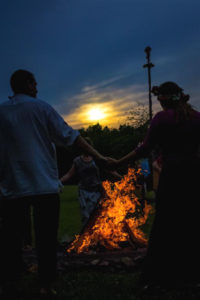

For other Earth Sanctuaries seasonal celebrations see: https://earthsanctuaries.net/category/seasonal-celebrations/
1 Kathleen Hannan http://www.kathleenhannan.com/
2 Starhawk
3 Cyntha R.Crossen http://cynthiasongs.com
4 The Beltane Brand dance is from the Dances of Universal Peace repertoire.https://www.dancesofuniversalpeace.org/
5 The All My Relations dance is from the Dances of Universal Peace repertoire.
Text (C) 2020 Betty Lou Chaika. Photos, except where noted are (C) Betty Lou and David Chaika
Barbara Janeway
Everything about your account takes me back to my many years of participating in women’s group sacred rituals, many of which were Maypole Beltane times. Thank you for your sharing – it takes me into comforting memories just as vivid as when they were unfolding. Merry meet, and merry part, and merry meet again, we certainly will, upon this plane or another, because we are so graced…….
Betty Lou Chaika
Yes, Barb, may we merrily meet again someday and participate together in sacred rituals of Earth, Spirit, and Community. I’m happy that this story brings back sweet memories!
Laurie Lindgren
Such wonderful, cherished memories. These ceremonies and offerings have made an indelible mark on hearts and souls even as they flow down the River of Time. Such a bright beautiful Light was created for the community and for Nature combining. I’m so grateful to have participated and for your leadership.
I never knew this about the Maypole: fervently helping to bring the light of the sun down to fertilize the Earth. What an extraordinary symbol of this time of year.
May bright fires of joy and creativity continue to burn in all our souls!🔥
Betty Lou Chaika
Laurie, you have been an integral part of so many, perhaps all, of these Beltane celebrations, adding your creative enthusiasm and fabulous musical talents to the beauty-making. Thank you for your partnership, your contributions, and for your support of all of our Earth-Spirit community offerings.
Beth
Dearest Betty Lou,
Thank you so much for sharing these memories! It was a great blessing to participate in this ritual and a pleasure to re-live it with you today!! I look forward to the day when we can gather yet again and share hugs and tales of life in between. Many blessings to you and David!!
Betty Lou Chaika
Beth, your enthusiastic participation in these celebrations added so much to the energy and vitality that made them such a success. Yes, may we merry meet, gathering together to share our love of Life again, soon!
ann loomis
I think of Beltane as a portal for the faery folk to make their appearance, energizing and balancing the land. The word “sovereignty” describes the land so well. It reminds me of the question, “What does a woman want?” She want sovereignty over her life, to make her own choices, and to plant her own intentions. This is a lovely ritual with the maypole as the Divine Masculine and the intertwining ribbons as the Divine Feminine. May we create a new world together that works for all of the land’s creatures!
Betty Lou Chaika
Dear Ann, thanks for evoking a vision of all of the unseen activity of the fairy realm busying themselves with “energizing and balancing” as taking place while we people did our best to do the same in the seen realm. Perhaps that’s why every one of these celebrations seemed to flow so magically! I love your description of sovereignty. Nature needs these same rights to grow and flourish in freedom. May your blessing, your prayer, your wishes for a new world of co-creation between people and the rest of the natural world come true!
Susan Baylies
I enjoyed this virtual journey through a sacred time in community. Thank You for sharing it.
Betty Lou Chaika
Susan, thank you for sharing in this virtual sacred ceremony to usher us into the bright half of the year, since we cannot gather in person as we shelter-in-place and, hopefully, heal.
Nancy Tusa
Betty Lou, thank you for so vividly describing the Beltane rituals you’ve led! As I read this, I was moved by the deep meaning and healing power of these rituals and celebrations for us today, as well as for our ancestors. I love the roles that water and fire play in the rituals and the idea of making a commitment to rekindle my own heart’s yearning every May Day. There is a great honoring of the individual, the community, and all forms of life and things that support life on this planet. The photos are gorgeous, too. I especially like the one of the Bealtaine sunrise at Beltany–the magical one where the sun sits on top of the apex of the boulder .
Betty Lou Chaika
Nancy, thank you for joining the celebration and letting yourself by moved by the deep meaning of this ceremonial time which reveals that there is a continuity of love flowing from our wise ancestors to us now. Yes, the powerful elements of water and fire are potent allies in both our communal and individual healing rituals. They can help us remove obstructions and focus our intentions. I hear what you say as a prayer: Yes, let us honor the individual, the community, and all forms of life and things that support life on this planet.
Sue-Anne (Sofianna)
Oh, I must respond! I skimmed over this beautiful writing yesterday, with a promise to spend more time savoring the details, and crafting a response. I am glad I waited! Today in the Mayan Tzolkin is TOJ, represented by the ceremonial fire! It is basically, as well, the wheel of karma, cause and effect, and the glyph is a wheel with a central axle. The lovely wheel of the year in this post reminded me of TOJ today. It is a day to give payment, offerings to the ceremonial fire, to be at peace with AJAW, the Great One. And the best offering we can make is our gratitude.
Today is a day where the energy place is beaches and big rocks, both of which I have right here, and I have just come back from a walk down to a little playita, a small, very quiet bay within a bay, watching great frigate birds circle overhead and hearing the cries and whistles of the great-tailed grackles which are plentiful here: What? Wow! Ow!
Today is a day to give thanks for both our benefits and challenges; and I continually open to an expanding ability to be grateful for the challenges! Today I am grateful for the challenge of this Time, since I am meeting it mostly with equanimity, and I see the great benefits OF this challenge!
I am doing a lot of writing, uniting Maya and Sufi wisdom, in what one day will be a book with 20 songs, each representing one of the Mayan Nawales and pairing each with one of the Sufi Names of God, as the Nawales also represent Divine Qualities.
I offer today’s song, Ya Shakur, for whoever would like to hear it. Let me know and I will send it to you. I also have been sending out some of my writing by email, contemplating the day’s Nawal and the Sufi Name. Please let me know if anyone would like to receive any of this. I know that at this time there is an almost overwhelming amount of information, workshops, Zoom meetings, etc., so let me know if you think you can handle one more piece of inspirational writing and songs!
Much love to everyone! Happy Beltane! And Happy Wesak Moon, coming right up. There is a beautiful song posted on Youtube to go with this auspicious day, should you care to check that out, too. Wesak Day Song by Brother Leonard Tan. So beautiful!
In lakesh,
S
Betty Lou Chaika
Thanks, Sofianna, for bringing us the connection of Beltane with the Mayan Day of the ceremonial fire and the wheel. I’m glad you are able to celebrate there in Mexico in the so-appropriate setting of beach and rock energies. Thank you for reminding us to offer our gratitude to the fire for both the gifts and the challenges of this incredible time. I wish you well (Ya Fattah!) in your wonderful work of connecting Mayan and Sufi divine wisdom teachings. Yes, why not send your songs to the whole Dances of Universal Peace community!
LibbyAnn Capaldi
Sweet Memories…
Many More Blessings to You Both
💫🤟💫
Betty Lou Chaika
Libby — Those were the days, my friend! A joyous Beltane to you “on the hill.”